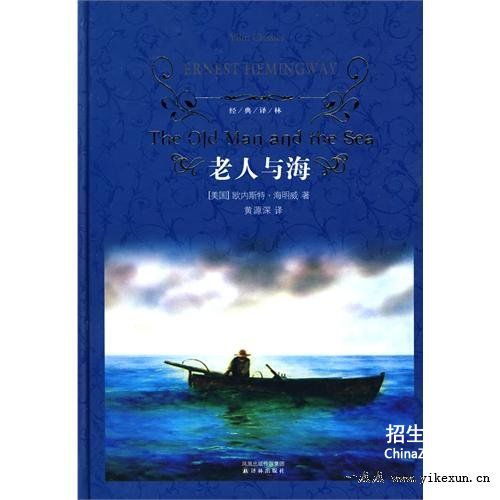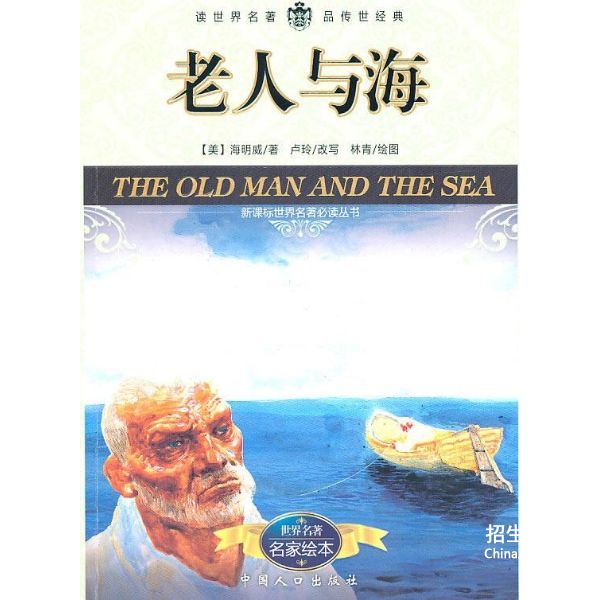【www.guakaob.com--美国留学】
《浅谈《老人与海》中的象征寓意》
老人与海的意思是什么 第一篇
浅谈《老人与海》中的象征寓意
——读《老人与海》有感
《老人与海》是美国作家海明威在1951年写的一篇中篇小说。起初是一部名为《现有的海》的长篇小说第四部分的结尾,因为博得友人的一致赞美,故事又相对独立,因此单独发表。发表后引起轰动,并为海明威带来了1953年度的普利策奖金以及1954年度的诺贝尔文学奖。
《老人与海》的故事非常简单,原文全文仅两万余字,海明威用简洁有力的语言、细致平实的白描手法描写了一个年迈的老人的一次撼动人心的“海上搏斗”:这个孤独的渔夫已经连续八十四天没有捕到鱼了,但他仍然不舍不弃,只身驾船赶赴人迹罕至的墨西哥海湾,经过两天两夜的殊死搏斗终于捕到了一条18英尺长的大马林鱼,并把它绑在了小船的侧舷上。但一大群饿疯了的鲨鱼却循着血腥味尾随而来,老人费尽力气,用掉了所有可以用的工具,仍然没有办法与鲨鱼对抗,鱼肉被凶恶的鲨鱼群瓜分得一干二净。最终老人只把一副空的大鱼骨架拖回了岸边。
海明威用失败的结局衬托出老人的悲剧色彩和不屈的硬汉精神,采用大量的象征手法,表达了作者对人与命运的斗争、生存与毁灭的价值的探讨,以及对自己人生的映射。
本文接下来通过对小说中主人公及一些物象的象征寓意的分析,浅谈作者通过这些象征手法所要表达的内涵。
(一)《老人与海》中主人公的象征意义
《老人与海》中最主要塑造的就是主人公圣地亚哥这个形象,这是一个经验丰富、意志顽强的渔夫,是作者一生的创作中“硬汉形象”的高度升华和总结,是一个悲剧性的英雄。贫穷和不走运使他不像传统的英雄那样伟大光鲜,他生活拮据,并且八十四天都没有钓到过一条鱼。但他没有放弃过希望,一次又一次充满信心地踏上出海的征程,并且总想着要去到远一点的地方,到没有人探索过的海域捕一条大鱼回来,证明自己仍然强健有力。
捕鱼对于圣地亚哥来说并不仅仅是维持生计的谋生之道,作为一个渔夫,他

感到去捕鱼就是自己的使命,也是人生的价值,因此捕到鱼就是渔夫尊严的证明。圣地亚哥说“这正是我生来该干的行当”①,于是他不断投入到与大海的搏斗之中,即使已经年迈苍老,渐渐力不从心,仍然缅怀着青春的激情与活力,追逐着理想。这是他性格中固执的一点,他不愿承认自己已经老去。此外,他还有些逞强。他与小男孩每天都要扯一套谎话,以至于小男孩都已经无法辨别他们对话中提到的物品究竟是否存在。老人虚构黄米饭,虚构渔网,也是为了维持他的自尊心。这也从侧面反映了“硬汉”的“风度”——不仅从老人与鱼的斗智斗勇上反映,从他的生活状态中也可以反映出来。
在与海上的鱼搏斗了三天三夜之后,老人最终疲倦而归,只带回一架空空的鱼骨。他失败了,但他却没有被打败,只要他还没有屈服,他就不承认自己被打败。“人不是为失败而生的,一个人可以被毁灭,但是不能给打败”②这句话突出地表达了圣地亚哥的“硬汉精神”,即不向命运低头,无论被如何摧毁,受到何种不公,仍然永不服输,顽强拼搏。虽然老人在这次捕鱼的行动中失败了,他却是生命的英雄,这种不屈的精神是永恒的,积极的,象征着作者在当时那个混乱不安的时代对理想与光明的追求以及人类对命运的抗争精神。

另外,我们还可以看出老人的曲折命运也隐喻着作者本身。海明威曾经参加过两次世界大战,身心都遭受战争的摧残。老人的那份沧桑、衰弱正是海明威经历战争后饱受创伤的状态。而那之后海明威连续十年都没有发表过什么重要作品,甚至引起过评论家的一致批评,许多人认为他已经文思枯竭、江郎才尽。这正是那个连续八十四天都没有捕到鱼的老人。感同身为渔夫却捕不上鱼的不堪,海明威也决心要写出一部“最好的作品”来证明自己的才华。完成这部小说后,海明威说“现在发表《老人与海》可以驳倒认为我这个作家已经完蛋的那一派批评意见”③,足见他是在用这部作品重获文学创作的尊严。
小说中多次写到老人由于老迈在捕鱼过程中的不甘。例如文中曾细致地描写了老人左手抽筋,表现了老人体能上受到的限制——老人并没有他所想的那么强壮,并且他也不断意识到这一点。“我恨抽筋,这是对自己身体的背叛行为。”④他急切地呼唤甚至责备自己的左手,以求它能在大鱼开始有所行动之前恢复知觉。经过一天多的对峙,老人几乎没有休息,他觉得自己还能熬夜,但是理智却告诉他应该睡一会觉。在后来与大鱼的搏斗中,他已经“感到头晕,恶心,看不大清
楚东西”⑤,他不断提醒自己要“保持头脑清醒,要像个男子汉,懂的怎样忍受痛苦”⑥。这个过程不仅是老人与大鱼在对抗,同时也是老人与自己的老迈在对抗。海明威早年在战争中受过许多肉体上的创伤,这些伤处在他的晚年给他带来无尽的痛苦。海明威和小说中的老人一样,自尊心很强,因此他不愿承认自己的年弱体衰。
年老是一股不可抗力,如同小说中的深不可测的大海、凶猛残暴的鲨鱼,在它们面前人类的力量是渺小的,要与它们拼搏,结局几乎是注定的。面对这最大的“摧残”,“老人”走到了他的骄傲允许走到的最后一刻。——《老人与海》是海明威的最后一部作品,在他完成了这部“人生总结”之后,1961年海明威自杀而亡。
即使自然法则可以毁灭海明威,然而精神却是无法被摧毁的。海明威通过这部作品表达了自己永不言败的意志,传达了人类的生存意义——孤独地拼搏,在自然与时间等巨大的力量中努力维持人类的尊严。海明威已经看到死亡之于尊严是没有影响的,并且在他看来,死是美丽的、壮阔的——如同那条美丽的大马林鱼,因此他对死也许并不畏惧。
(二)《老人与海》中其他物象的象征意义
(1)大海
不难看出,大海象征着人生的搏斗场,是每个人的人生舞台。这个场所深不见底,仁慈又凶猛,既如女性一般阴柔,也是“黑色的”“黑暗的”,象征着变幻莫测、包容万象的势力。在这个舞台上,有着物竞天择、弱肉强食的自然法则,也有着与老人争夺鱼肉的鲨鱼那样的残暴不公的强权者。在海上不断地航行,就如同生命在流逝一般。不断地得到,又再失去,最终回到如同青春时代般的活力饱满的状态,又再次踏上征途。
(2)鲨鱼【老人与海的意思是什么】
鲨鱼象征着一切凶恶的势力、破坏性的力量,他们掠夺成性,不考虑公正或应得,只凭借自身的力量去摧残对手,抢夺猎物。他们嗅到血腥就会趋之若鹜,当那条臭迹变得很宽的时候,“它们竟然不用到处来回搜索这臭迹。它们并肩笔直地朝小帆船游来。”足见它们的贪婪和狡猾。鲨鱼的力量是凶残的,从而更衬
⑦【老人与海的意思是什么】
托出与之殊死拼搏的老人的顽强。
另外,在小说结尾处,有一个旅行者和侍者错将马林鱼的鱼骨当成鲨鱼的鱼骨,把好不容易从鲨鱼嘴中夺回来的鱼骨当成了罪魁祸首的骨头,这显然是一种嘲讽。嘲讽世人对老人用尽全力拼搏的战斗的无知,不仅混淆是非,反而还赞叹起了破坏者。
(3)马林鱼
马林鱼的象征意义是丰富的。它象征着目标、理想、追求,又象征着对手、劲敌;在孤独的海上,老人常常与大鱼对话,他爱这条大鱼,因此这条鱼又象征着朋友、尊敬者;最后这条鱼的鱼骨被带回来,渔夫们惊讶地测量它的长度,对老人升起一丝敬意,又表明这条鱼象征着成功、辉煌与光荣。——虽然最后,老人并没有把鱼完整地带回来,这份光荣也就打了折扣,被世人所误解。

老人与马林鱼的关系是很微妙的。一方面,他赞美这条鱼,赞美它的机智、它的坚持、它对痛苦的忍耐。在老人看来,马林鱼就和自己一样,他们的搏斗中有相当一大段时间是在互相僵持。“他选择的是呆在黑暗的深水里,远远地避开一切圈套、罗网和轨迹。我选择的是赶到谁也没到过的地方去找它”“如今我跟它给拴在一起了。„„而且我和它都没有人来帮忙。”“你现在觉得痛了吧,鱼。我也是如此。”⑧他一边与鱼僵持,一边判断着鱼的状态,这时他便站在鱼的角度思考,思考它的感受,猜测它会走的方向,并不断地认同、尊敬这条鱼。另一方面,在表达对鱼的赞美的同时,老人仍然不忘自己的使命,非要杀死它不可。“我要跟你奉陪到死。”“它能熬多久,我也能熬多久。”⑨丝毫没有放手的意味。在他与鱼拼搏的白热化阶段,他差点萌生了就这样让鱼把自己害死得了的想法,然而又马上提醒自己应该清醒过来,要懂得忍受痛苦,“或者像一条鱼那样”。他非常尊敬这条鱼,但是征服它才是老人的最终目的,是老人的生存价值,因此他们的敌对是必然的,对目标、成功的追求也是必然的。然而老人对待鱼的态度告诉我们也应该赞美对手、尊敬对手、把对手当成朋友。因为它们是实现自我价值的过程中不可缺少的一部分。
(4)狮子
小说中有数次提到了狮子这个物象。狮子象征着青春、激情与力量。第一次是老人和小男孩谈论起棒球时顺便提到的,老人说“我像你这个年纪,就在一条
⑩
⑾去非洲的横帆船上当普通水手了,我见过狮子在傍晚到海滩上来”。这说明狮子
是老人在盛年时见过的,狮子使老人回想起自己年轻力壮的时候,那时他充满了激情与雄心。后来在海上,老人孤独地与大鱼作漫长的对峙,这时他更加需要勇气与力量。老人想,“但愿我也能睡去,梦见狮子”就是借狮子来鼓励自己,使疲惫不堪的自己重新获得精神支持。因为老人想要回到充满力量的青春年代,想要证明自己还未老去。
小说的最后一句话也提到了狮子。“老人正梦见狮子” ⒀他回到岸边,回到有小男孩帮助、有其他渔人们刮目相看的岸上,也代表着他的青春的回归。然而他带着满身创伤,甚至说“感到胸膛里有什么东西碎了。” ⒁老人还能再次恢复体力出海打渔吗?这是个未知数,然而他正梦见狮子。小说结尾用狮子再次点明主题:他的希望永不破灭,他的精神永不被摧毁。
《老人与海》这部小说中还有许多象征意义,比如小男孩象征着希望与活力,小说中老人的几次劫难象征着基督耶稣的受难等等。《老人与海》是一部在语言上通俗易懂、情节上扣人心弦、情感上震撼人心的作品,同时在艺术手法上也有很大的研究价值。这部作品背后更深的审美价值和作者的意识表达也还可以进一步研究。它超越时空带给人们的启发和研究价值,使这部作品成为当之无愧的世界经典。
注释:
①:海明威著 吴劳译 《老人与海》 上海译文出版社 2004年7月 第69页【老人与海的意思是什么】
②:同上 第122页
③:《海明威谈创作》 三联书店 1985年 141-142页
④:海明威著 吴劳译 《老人与海》 上海译文出版社 2004年7月 第80页
⑤⑥:同上 第112-113页
⑦:同上 第132页
⑧:同上,分别摘自69页,75页
⑨:同上 第71页
⑩:同上 第112页
⑿
《老人与海的象征意义》
老人与海的意思是什么 第二篇
An Analysis of Symbolic Meanings in The Old Man and the
Sea
Introduction
The author of The Old Man and the Sea, Ernest Miller Hemingway was born on July 21, 1899 in Oak Park, Illinois, a suburb of Chicago. His father Clarence Edmonds Hemingway was a physician, and his mother Grace Hall–Hemingway was a musician. Both were well-educated and well-respected in the conservative community of Oak Park. The family owned a summer home called Windermere on Walloon Lake, near Petoskey, Michigan, which they visited during the summers. There Hemingway learned to hunt, fish, and camp in the woods and lakes of Northern Michigan. His early experiences with nature instilled a lasting passion for outdoor adventure, living in remote or isolated areas, hunting and fishing. His variety of interest, especially the love of fishing extremely affected all his life and he drew much writing inspiration from his fishing experience. Taking adventures also plays a vital role in his life and for the reason that he experienced the two world wars. Hemingway attended World War I as an ambulance driver of Red Cross. He received the Italian Silver Medal of Bravery because of his prominent performance in the battlefield. He was sent to Europe for a long time. He joined World War Ⅱ and Spanish Civil War as a journalist. All these rich experiences brought much material to his writing.
He worked as a journalist before becoming a novelist. During his high school time he attended The Kansas City Star as a reporter, where he learned that the truth was often beneath the story. Although he worked at the newspaper for only six months, he established his writing style that short sentences and short first paragraphs were used and positive but not negative attitude was presented in his reports. After published many famous works, he developed his own writing style. Since 1940 he did not issue any works for ten years. As a mouthpiece of ―the lost generation‖, Hemingway suffered cold shoulder and attack almost ten years in the commentary
field. In order to save the desperate situation, Hemingway wrote a work that he firmly believes to be the best works in his life, which was called The Old Man and the Sea, which is the inheritance and development of Hemingway’s unyielding character. In 1954, Hemingway was awarded the Nobel Prize for Literature because of his mastery of the art of modern narration. Hemingway’s writing style is that meaning is established through dialogue, through action, and silences and few themes or comments are described explicitly. The Iceberg Theory of Hemingway advocated that the hard facts and the main structure floating above the sea were written and all others were omitted.
In the early 1950s, the Cuban people’ movement for national independence and liberation gradually reached its peak. Hemingway was living in Cuba at that time and was inspired by heroic Cuban people’ unyielding and indomitable spirit of tenacious struggle. What he saw and heard constantly in Cuba stimulated his creative inspiration and passion.
1 A brief introduction to The Old Man and the Sea
The Old Man and the Sea is one of Hemingway's most enduring works. Told in language of great simplicity and power, it is the story of an old Cuban fisherman, down on his luck, and his supreme ordeal——a relentless, agonizing battle with a giant marlin far out in the Gulf Stream. Written in 1952, this hugely successfully novella confirmed his power and presence in the literary world and played a huge part in his winning the 1954 Nobel Prize for Literature.
Santiago was an impoverished fisherman. All possessions he owned were his shabby suits and the shack he lived at. And the shack only contained a table, a chair, a bed and an oven. Much worse thing was that Santiago had been without catching a fish for 84 days. In first 40 days he was accompanied by a little boy, Mandolin. But the boy was forced to leave him on account of his parents’ thinking of the worst luck of the old man’s skiff. Though be forced to leave him, the boy often helped Santiago take fishing gear from the shore to his shack and admired him for his fishing skills.
However, in Terrace Santiago was always derided by local villagers. Santiago was full of wrinkles in the back of neck and brown blotches in his cheeks, but his eyes were incredibly cheerful and undefeated. Sometimes the old man would discuss the baseball with the boy and talk of DiMaggio, the greatest baseball player in his mind.
After woke up in the morning, Santiago left his shack and went Mandolin’s home. He woke up the little boy and then they had a coffee in a restaurant. The boy assisted the old man with taking fishing gear and Santiago set out. By observing the bird to catch fishes and schools of small fishes he successfully got a ten-pound albacore tuna. Later a huge marlin commenced striking his bait and after a turn she ate his bait. From that moment on the marlin dragged his skiff for one day. During the course his forehead was injured.
As sunrise came, Santiago entered the second day of the journey. There were some fishes that took his baits when the huge marlin was drawing his skiff. But he cut off the line immediately and made it fasten to the reserve coils. At last there were six reserve coils prepared for the gigantic marlin. Through many monologues and thinking of DiMaggio or his own experiences he endured all agonies successfully.
The sun rose for the third time and the old man was pleased to see that the fish began to circle. He felt faint and managed to keep his mind clear. The marlin was stabbed by his harpoon eventually and Santiago made it fasten to the skiff. The fresh blood of the marlin drew attention of sharks. These hateful sharks attacked his game five times. The old man battled against sharks with all tools and force. The hero sailed into the harbor with an immense skeleton of his catch. He furled the sail and shouldered the mast alone.
2 Symbolisms and The Old Man and the Sea
Symbolism is an approach writers often employ in their writing. It is an approach that sort of concrete objects are used to express minds or some pretty meaningful theories of writers. There are no necessary relationships between these concrete things and minds or theories that writers intend to express. However, when readers read
these concrete things that portrayed in their works, it will arouse their association and help readers comprehend their minds and theories through their characteristics. Writers often employ something be familiar with people to convey their special meanings according to traditions or customs. For example, the color red means happiness and the dove is a symbol of peace in China. The writing approach of symbolism makes abstract and complicated meanings or theories easier to be understood, extends association of readers and enhances effect of writings.
Hemingway grew in the time that symbolism was embodied and expanded from circle of poet into the field of literature. Hemingway himself also thought that the novel should be like an iceberg; the one-eighth reveals above the water, the other seven-eighths hide deeply in the water, which needs the reader himself to understand. In other words, one has to keep a close eye on Hemingway’s words and reading between the lines because of his highly symbolic language. The theme and the description of The Old Man and the Sea is very simple, because it reveals only one -eighth on the face, the rest seven-eighths are hidden, when reading carefully and learning about the culture and situation at that time, you can understand the real hidden part by the writer. Gao Heshun thinks that Hemingway believed as a good writer, he didn’t need to reveal the action or characters clearly; obscurity can give us the aesthetic sense. (Gao Heshun, 2005)
The plot of the novel is pretty simple. The novel is mainly portrayed through Santiago’s monologues and recollection. There is little description about Santiago’s life. Authors could have depicted abundantly the background of the little fishing village and characteristics of each man in novel in other great works, but he did not. Hemingway inclined to portray his work implicitly and describe things objectively. He objected to making comment on the hero’s feeling or the theme of novel directly. In the novel he only portrayed characters and their actions, which is known as one-eighth iceberg above the sea. The other seven-eighths are omitted and it is that lead all readers to read the work from individual perspective and get a different conclusion related to their conditions of life. Symbolism makes the novel concise but abundant in meaning. The concrete things in the novel can stand for many realistic
things.
3 An analysis of symbolic meanings in The Old Man and the Sea
There are many symbols in this story, such as the old man, the boy, the sea, the shark, the marlin and etc. This paper only focuses on the important symbols and analyzes the deep meanings of them.
3.1 Symbolic meanings of the sea
The sea stands for the world we live in. We live in the world just like a skiff floating in boundless sea. Sometimes she is peaceful and we can live with happiness. Like the old man Santiago, he also had ever caught many titanic fishes. Through his recollection we know he was respected by local villagers for his defeating the strongest black man of the harbor. Sometimes we are teased by the world. Santiago had been without caught a fish for eighty-four days. Clinton wrote that for the bird who rests on his line and for other creatures who share with him such a capricious and violent life, the old man feels friendship and love.(Clinton S.Burhans, JR, 2003) Although he was confident about his own fishing skills and endured the intolerable tiredness, he lost his game in the way home eventually. Also we are disturbed by the unpredictable world. Though the poisonous man-of-war was the most falsest creature in the sea, it was nice food for turtles. “The turtles saw them, approached them from the front, then shut their eyes so they were completely in carapace and ate the filaments and all.”(Ernest Hemingway, 2007) But the hateful sharks would cut the turtles’ legs and flippers off when the turtles were sleeping on the surface of the sea. And little fishes would be eaten by tunas. All scenes that portrayed in the novel lead readers to relationships among human beings in contemporary world. In this world each people are connected with their interests. The people of upper class take up all kinds of resources of society. In contrast the people of lower class strive for a better life but in vain. The sea is something that Santiago must rely on. He could not live without the sea and the sea is his resource of life. It is also true of us. Though cannot
《老人与海——大海的象征意义》
老人与海的意思是什么 第三篇
《老人与海》——大海的象征意义
大海是在不同的地方有不同的意义,当然在每个人眼中,大海也是不同的。有的人喜欢大海;有的人害怕大海;有的人以大海为生,就像《老人与海》中的老人一样;没有大海就没有圣地亚哥,就没有我们后面所看到的“硬汉”形象!
我们都知道,大海是广袤无垠的,而老人和大海相比是微不足道的,而同时老人和大海是分不开的,作者利用大海的一切来衬托出老人那勇敢无畏的“硬汉”精神。老人喜欢大海,当小男孩离开他之后他就更孤独了,他一个人孤独的飘荡到大海的深处,即使84天都没有打到鱼,但是他仍然没有一点的放弃,在第85天的时候仍然和往常一样出海捕鱼!老人想从大海中来证明他自己的人生价值。
《老人与海》排除了一切可以排除的社会性因素,让老人只身一人面对大海,诉说一个最古老而又最伟大的文学主题:人与自然的关系。这样,作家就站在一个更高的视点,思考了人类的命运及人们如何面对自己的命运。
大海象征着老人的生存环境,它在整篇故事中起着举足轻重的作用,它是圣地亚哥老人赖以生存的物质世界,是他生活的全部内容,海为他准备了神秘的大鱼,为他提供了展示其无比的勇气和毅力的场所。
一方面,大海代表着大自然,圣地亚哥在自然中生存,并且在大自然中努力的生存奋斗,大自然是神秘的是伟大的是具有无穷力量的,它养育了很多人,鲨鱼,马林鱼,海燕等,而老人也是靠大海生存的。独自在海上的日子,圣地亚哥看日升日落、观月隐月现,与鱼鸟作伴,和风水对话,他也变成了大海的一部分。这时候大海是美好的。
但是大海又是十分残酷的,老人辛辛苦苦抓到的大马林鱼;用生命的力量去抓到的马林鱼;花费了几天几夜抓到的马林鱼;手受伤了没有东西吃饿着肚子抓到的马林鱼最后被成群结队而来的鲨鱼夺走了。那个可以证明老人的人生的价值的马林鱼被夺走了。
另一方面,大海代表着二战结束后当时的社会状况。当时麦卡锡主义在美国猖獗横行,民主与进步力量遭到疯狂的迫害,整个美国社会弥漫着疑惧和恐怖的气氛,但作为一个目光敏锐的记者、坚定的反法西斯战士、富有正义感的作家,海明威通过《老人与海》向读者传达出对黑暗现实的控诉。
老人的孤独与快乐、斗争与失败都和大海相联系。老人与大海的关系是既依存于大海又要与大海斗争。他不仅仅从大海获得生存条件、生存技巧,还从大海获得朋友和对手。大海是他的生活场所和战斗场所,也将成为他的最后归宿,这与海明威的生活经历有着极其重要的关系。
《老人与海》为什么称之为“老人与海”而不是“老人与小男孩”或者“老人与马林鱼”,老人在大海上最主要的就是和大马林鱼的斗争还有接下来和鲨鱼的斗争,作者之所以选择大海,是因为不管是老人和马林鱼的斗争还是老人和鲨鱼的斗争,哪怕是一开始小男孩的离开,是因为他在大海里没有捕到鱼,很多事情都和大海或多或少的联系。他们包括老人都是在大海上上演他们的悲欢胜败。所以大海在《老人与海》中意义非凡。
《老人与海简介》
老人与海的意思是什么 第四篇
桑提亚哥是古巴的一个老渔夫,他年轻时非常出色,强健有力,他曾经和一个黑人比赛掰腕子,比了一天一夜,最后终于战胜了对手。到了晚年,他的经历和反应都不如从前,老婆死后,他一个人孤独地住在海边简陋的小茅棚里。
有一段时间,老渔夫独自乘小船打鱼,他接连打了84天,但一条鱼也没有捕到。本来一个叫曼诺林的男孩子总是跟他在一起,可是日子一久曼诺林的父母认为老头悖运,吩咐孩子搭另一条船出海,果然第一个星期就捕到三条好鱼。老人与海简介。孩子每次见到老头每天空船而归,桑提亚哥瘦削憔悴,后颈满是皱纹,脸上长着疙瘩,但他的双眼象海水一样湛蓝,毫无沮丧之色。他和孩子是忘年交。老头教会孩子捕鱼,因为孩子很爱他。村里很多打鱼的人都因为老头捉不到鱼拿他开玩笑,但是在曼诺林的眼里,老头是最好的渔夫。他们打渔不但是为了挣钱,而是把它看作共同爱好的事业。孩子为老头准备饭菜,跟他一起评论垒球赛。老人与海简介。老头特别崇拜垒球好手狄马吉奥。他是渔民的儿子,脚跟上虽长有骨剌,但打起球来生龙活虎。老头认变自己已经年迈,体力不比壮年,但他懂得许多捕鱼的诀窍,而且决心很大,因此他仍是个好渔夫。
老人和孩子相约第二天,也就是第85天一早一起出海。半夜醒后他踏着月光去叫醒孩子,两人分乘两条船,出港后各自驶向自己选择的海面。
天还没有亮,老头已经放下鱼饵。鱼饵的肚子里包着鱼钩的把子,鱼钩的突出部分都裹着新鲜的沙丁鱼。鱼饵香气四溢,味道鲜美。
正当桑提亚哥目不转睛地望着钓丝的时候,他看见露出水面的一根绿色竿子急遽地附入水中。他用右手的大拇指和食指轻轻捏着钓丝。接着钓丝又动了一下,拉力不猛。老头明白,一百英寻之下的海水深处,一条马林鱼正在吃鱼钓上的沙丁鱼。他感觉到下面轻轻的扯动,非常高兴。过了一会儿他觉得有一件硬梆梆、沉甸甸的东西,他断定这是一条大鱼。这激起他要向它挑战的决心。
老人先松开钓丝,然后大喝一声,用尽全身的力气收拢钓丝,但鱼并不肯轻易屈服,非但没有上来一英寸,反而慢慢游开去。老头把钓丝背在脊梁上增加对抗马林鱼的拉力,可是作用不大,他眼睁睁地看着小船向西北方飘去。老头想鱼这样用力过猛很快就会死的,但四个小时后,鱼依然拖着小船向浩渺无边的海面游去,老头也照旧毫不松劲地拉住背在脊梁上的钓丝。他们对抗着。
这时,老人回头望去,陆地已从他的视线中消失。太阳西坠,繁星满天。老人根据对星的观察作出判断:那条大鱼整夜都没有改变方向,夜里天气冷了,老头的汗水干了,他觉得浑身上冷冰冰的。他把一个麻袋垫在肩膀上的钓丝下面减少摩擦,再弯腰靠在船头上,他就感到舒服多了。为了能坚持下去,他不断的和鱼、鸟、大海对话,不断的回忆往事,并想到了曼诺林,他大声地自言自语:“要是孩子在这儿多好啊,好让他帮帮我,再瞧瞧这一切。”
破晓前天很冷,老头抵着木头取暖。他想鱼能支持多久我也能支持多久。他用温柔的语调大声说:“鱼啊,只要我不死就要同你周旋到底。”太阳升起后,老头发觉鱼还没有疲倦,只是钓丝的斜度显示鱼可能要跳起来,这正是他求之不得的事。他说:“鱼啊,我爱你,而且十分尊敬你。可是今天天黑以前我一定要把你弄死。”鱼开始不安分了,它突然把小船扯得晃荡了一下。老头用右手去摸钓丝,发现那只手正在流血。过了一会他的左手又抽起筋来,但他仍竭力坚持。他吃了几片金枪鱼肉好增加点力气来对付那条大鱼。
正在这时钓丝慢慢升起来,大鱼终于露出水里。在阳光下,这浑身明亮夺目,色彩斑斓。它足有18英尺长,比他的船还要大。它的喙长得象一根垒球棒,尖得象一把细长的利剑。它那大镰刀似的尾巴入水中后,钓丝也飞快地滑下去。
老人和大鱼一直相持到日落,双方已搏斗了两天一夜,老头不禁回想起年轻时在卡萨兰卡跟一个黑人比赛扳手的经历。他俩把胳膊肘放在桌上划粉笔线的地方,前臂直,两手握紧,就这样相持了一天一夜。八小时后每隔四个钟头就换一个裁判,让他们轮流睡觉。他和黑人的手指甲里都流出血来。赌注给黑人的渔民喝了朗姆酒使出全身力气,竟把他的手压下去将近三英寸,但桑提亚哥又把手扳回原来的位置,并且在第二天天亮时奋力把黑人的手扳倒,从此他成了人们心目中的“冠军”。
老人和大鱼的持久战又从黑夜延续到天明。大鱼跃起十二次后开始绕着小船打转。老人头昏眼花,只见眼前黑点在晃动,但他仍紧紧拉着钓丝。当鱼游到他身边时,他放下钓丝踩在脚下,然后把鱼叉高高举起扎进鱼身。大鱼跳到半空,充分展示了它的美和力量,然后轰隆一声落到水里,浪花溅满老头一身,也溅湿了整条小船。
鱼仰身朝天,银白色的肚皮翻上来,从它心脏流出来的血染红了蓝色的海水。老头把大鱼绑在船边胜利返航。可是一个多小时后鲨鱼嗅到了大鱼的血腥味跟踪而至抢吃鱼肉。老头见到第一条游来的鲨鱼的蓝色的脊背。他把鱼叉准备好,干掉了第一只鲨鱼。几小时后又两条鲨鱼逼近船尾去咬大鱼的尾巴,老头用刀系在船桨上杀死了两条来犯的鲨鱼,(读后感 )但在随后的搏斗中刀也折断了,他又改用短棍。然而半夜里鲨鱼成群结队涌来时,他已无对付他们了,但他坚持搏斗,甚至把船舵都打断了,最后鲨鱼还是吃光了老人两天的辛劳,只剩下鱼头和鱼尾……
船驶进小港老人回到窝棚,天亮后人们看见船旁硕大无比的白色鱼脊骨,大家都惊叹老人桑提亚哥。
一天早上,孩子来看望老头,见到他疲倦得熟睡不醒时不禁放声大哭。老头醒来后,孩子给他端一杯热气腾腾的咖啡。两人相约过几天一起去打鱼,孩子说他还有很东西要学。孩子离去后,老头睡着了,他又梦见非洲的狮子……
老人与海简介(二)
文/乔文卜
<老人与海>从本质上不是部情节小说,而是部寓言小说,它通过老渔夫桑提亚哥与大鲁博斗中体现顽强战斗的硬汉子精神。作品所揭示的硬汉子精神就是敢于向命抗争,向失败和死亡进行挑战的精神;他可能在与大自然,与社会黑暗,与自自身博斗中一次失败,但人的不甘失败精神却是永远也打不挎的。
<老人与海>简洁准确的动作描写,语言洗练含蓄,富有韵味的内心独白,使整个小说像一幅油画,像一首诗,具有强烈的画面感和音乐感。它这种洗练简洁风格是较完美地体现了海明威的“冰山”理论;而那种重视语言视觉、听觉、触觉的效果,更使读者身临其境之感。这篇中篇小说以完美艺术性和深邃哲理性征服了世界文坛。这样,一九五四年,“因为他精通于叙事艺术,突出地表现在其近着<老人与海>之中;同时也因为他对当代文体风格之影响。”而获诺贝尔文学奖。